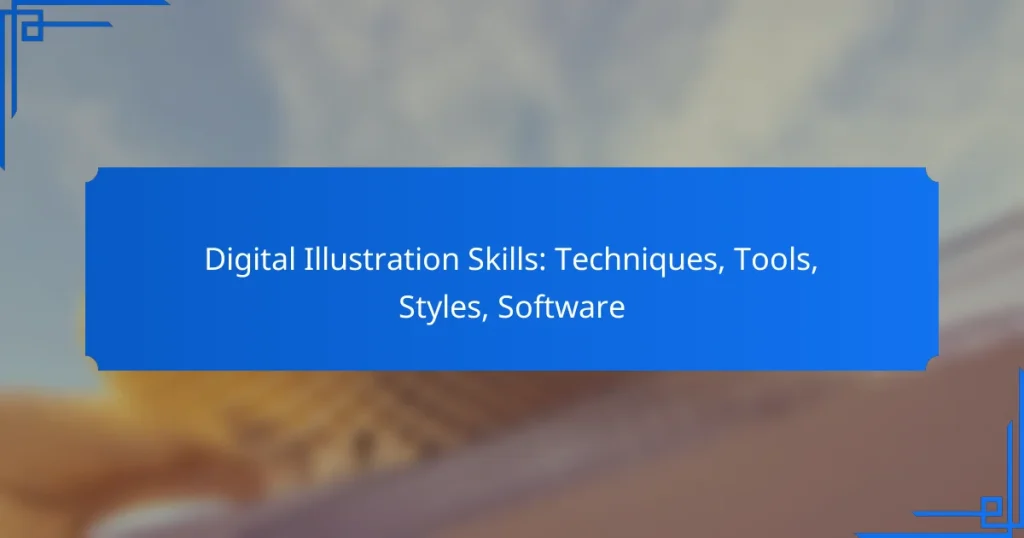Digital illustration encompasses a variety of techniques, tools, and styles that cater to different artistic needs and outcomes. From vector and raster graphics to 3D modeling and digital painting, each method offers unique advantages for creators. Selecting the right software is crucial, as it enhances creativity and streamlines the workflow, allowing artists to produce high-quality artwork across diverse styles, including flat design, realism, and surrealism.
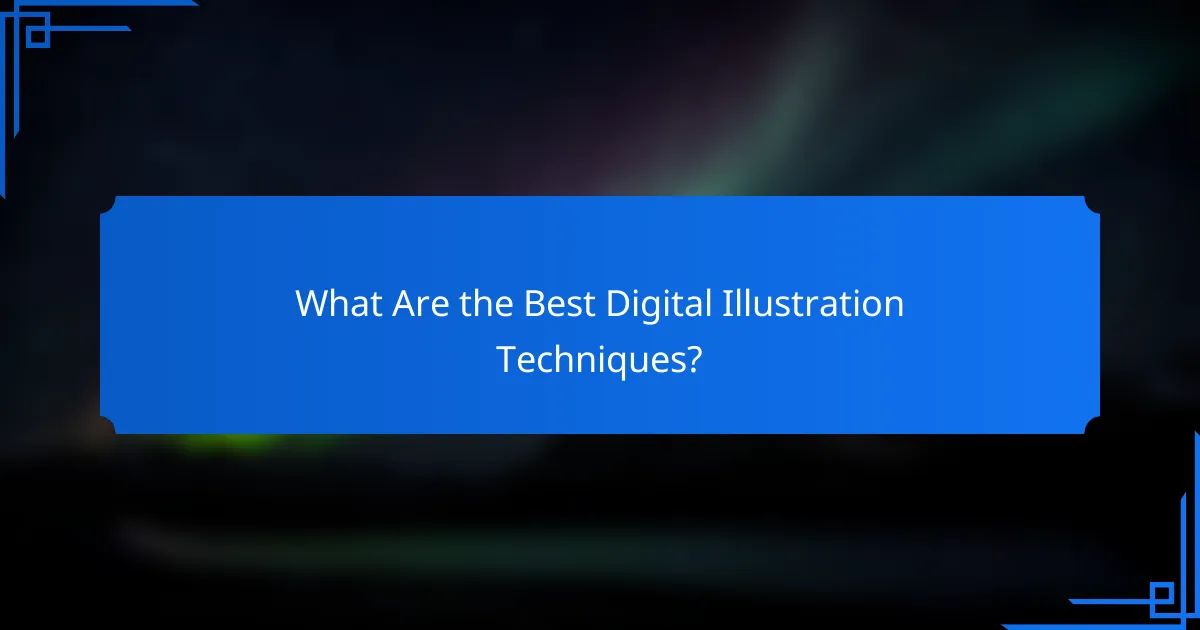
What Are the Best Digital Illustration Techniques?
The best digital illustration techniques vary based on the desired outcome and the tools available. Key techniques include vector, raster, 3D, mixed media, and digital painting, each offering unique advantages and applications.
Vector Illustration
Vector illustration uses mathematical equations to create images that can be scaled without losing quality. This technique is ideal for logos, icons, and illustrations that require clean lines and sharp edges. Common software for vector illustration includes Adobe Illustrator and CorelDRAW.
When working with vector graphics, focus on using layers and grouping elements for better organization. Avoid overly complex shapes that can complicate the design process and increase file size.
Raster Illustration
Raster illustration involves creating images using a grid of pixels, making it suitable for detailed and textured artwork like digital paintings or photographs. Popular software for raster illustration includes Adobe Photoshop and Procreate. Keep in mind that raster images can lose quality when resized.
To achieve high-quality results, work with high-resolution files and utilize layers for different elements. Be cautious of the file size, as larger images can slow down your workflow and take up significant storage space.
3D Illustration
3D illustration creates lifelike images using three-dimensional modeling techniques. This approach is commonly used in animation, gaming, and product visualization. Software like Blender and Autodesk Maya are popular choices for 3D artists.
When starting with 3D illustration, familiarize yourself with basic modeling, texturing, and lighting techniques. Experiment with different styles and perspectives to enhance the realism of your work.
Mixed Media Techniques
Mixed media techniques combine traditional and digital methods to create unique artwork. This can involve scanning hand-drawn elements and integrating them with digital tools. Artists often use software like Adobe Photoshop to blend these elements seamlessly.
To effectively use mixed media, consider the balance between digital and traditional components. Experiment with different textures and materials to add depth and interest to your illustrations.
Digital Painting
Digital painting mimics traditional painting techniques using digital tools, allowing for a wide range of styles and effects. Artists can use software like Corel Painter or Adobe Fresco to create stunning artwork that resembles oil or watercolor paintings.
When digital painting, focus on mastering brush techniques and color blending. Utilize layers to separate different aspects of your artwork, and don’t hesitate to experiment with various brushes to find your unique style.

Which Tools Are Essential for Digital Illustration?
Essential tools for digital illustration include software that caters to various styles and techniques, allowing artists to create and manipulate images effectively. The right tool can enhance creativity, streamline workflow, and improve the quality of the final artwork.
Adobe Illustrator
Adobe Illustrator is a vector graphics editor widely used for creating illustrations, logos, and typography. Its precision and scalability make it ideal for designs that require resizing without loss of quality.
Key features include a robust pen tool, extensive shape-building capabilities, and a variety of brushes. Illustrator is suitable for both beginners and professionals, but it may require a subscription, which can be a consideration for budget-conscious artists.
Procreate
Procreate is a popular digital painting app designed specifically for iPad users, known for its intuitive interface and powerful brush engine. It allows artists to create detailed illustrations using a stylus, making it a favorite among illustrators and graphic designers.
With features like customizable brushes, layering options, and high-resolution canvases, Procreate supports a wide range of artistic styles. It’s a one-time purchase, making it accessible for those who prefer not to commit to a subscription model.
Corel Painter
Corel Painter is a digital art software that mimics traditional painting techniques, offering a vast array of brushes and textures. It is especially favored by artists who want to replicate the look of oil, watercolor, or acrylic paints in a digital format.
This software is ideal for creating fine art and illustrations that require a traditional touch. While it offers a comprehensive set of tools, the learning curve can be steep for new users, and it typically comes with a higher price tag compared to other options.
Clip Studio Paint
Clip Studio Paint is a versatile illustration software that excels in comic and manga creation. It provides a range of tools tailored for line art, coloring, and panel layout, making it a go-to choice for comic artists.
Its features include vector layers, customizable brushes, and 3D models for reference, which can significantly speed up the illustration process. Clip Studio Paint offers a one-time purchase option, making it budget-friendly for aspiring and established artists alike.
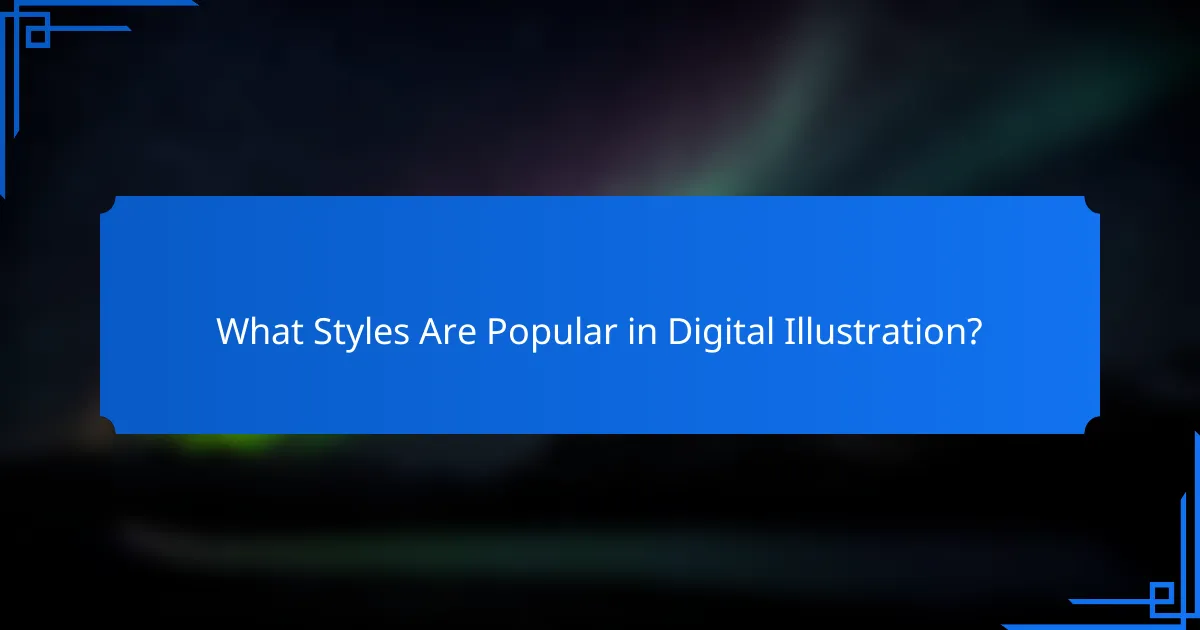
What Styles Are Popular in Digital Illustration?
Popular styles in digital illustration include flat design, realistic illustration, cartoon style, and surrealism. Each style has distinct characteristics and applications, appealing to different audiences and purposes.
Flat Design
Flat design is characterized by minimalistic elements, bold colors, and a lack of three-dimensional effects. This style emphasizes simplicity and clarity, making it ideal for user interfaces and branding.
When creating flat designs, focus on using geometric shapes and a limited color palette. Avoid gradients and shadows to maintain the flat aesthetic. Popular tools for flat design include Adobe Illustrator and Sketch.
Realistic Illustration
Realistic illustration aims to replicate real-life subjects with high detail and accuracy. This style often involves intricate shading, textures, and lifelike proportions, making it suitable for editorial work and product visualization.
To achieve realism, artists should study anatomy and lighting. Techniques like digital painting or 3D modeling can be employed, using software such as Adobe Photoshop or Corel Painter. Practice is essential to master the nuances of this style.
Cartoon Style
Cartoon style features exaggerated features, vibrant colors, and playful themes. This style is often used in animations, children’s books, and marketing materials due to its engaging and approachable nature.
When working in cartoon style, focus on character design and storytelling through visuals. Simplified shapes and bold outlines help convey emotions effectively. Tools like Procreate and Adobe Animate are popular for creating cartoon illustrations.
Surrealism
Surrealism combines dream-like elements with unexpected juxtapositions, creating thought-provoking visuals. This style often explores themes of fantasy and the subconscious, making it popular in fine art and conceptual projects.
Artists should experiment with unusual combinations and perspectives to evoke emotions and provoke thought. Techniques such as photo manipulation or digital collage can enhance surrealistic effects. Software like Adobe Photoshop is commonly used for these creations.
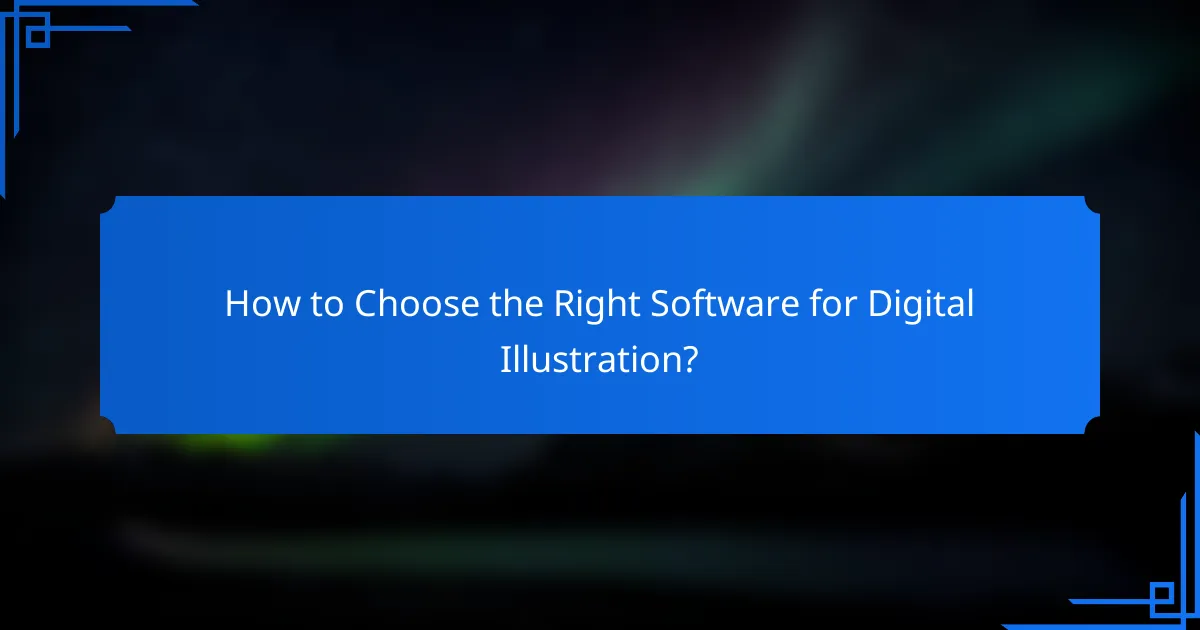
How to Choose the Right Software for Digital Illustration?
Selecting the right software for digital illustration depends on your specific needs, skill level, and budget. Consider factors such as compatibility with your devices and the features that align with your artistic style.
Consider Your Skill Level
Your skill level plays a crucial role in choosing digital illustration software. Beginners may benefit from user-friendly programs with intuitive interfaces, while more experienced artists might prefer advanced tools that offer greater customization and control.
For instance, software like Adobe Fresco or Procreate is often recommended for novices due to their straightforward design, whereas Adobe Illustrator or Corel Painter may suit those with more advanced skills seeking complex functionalities.
Evaluate Compatibility with Devices
Check the compatibility of the software with your devices before making a decision. Some programs are optimized for specific operating systems, such as Windows or macOS, while others may be available on tablets or mobile devices.
For example, Procreate is exclusive to iPad, making it a great choice for users of that platform, while Adobe Creative Cloud offers cross-platform compatibility, allowing access on both desktop and mobile devices.
Assess Budget and Licensing Options
Budget is a key consideration when selecting digital illustration software. Prices can vary widely, from free options like Krita to subscription-based services like Adobe Creative Cloud, which may cost around $20 to $50 per month depending on the plan.
Additionally, consider whether you prefer a one-time purchase or a subscription model. Some users may find that a one-time purchase fits their needs better, while others might appreciate the continuous updates and new features offered through subscriptions.
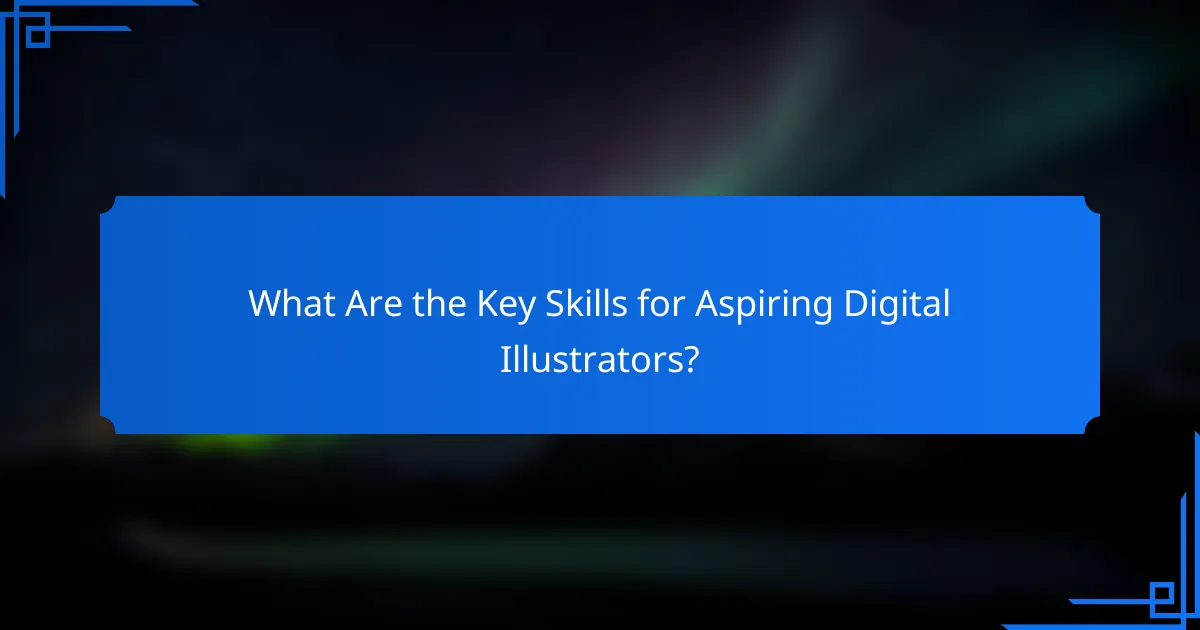
What Are the Key Skills for Aspiring Digital Illustrators?
Aspiring digital illustrators should focus on mastering color theory, composition, and drawing skills. These foundational abilities enhance creativity and technical proficiency, enabling artists to create compelling visual narratives.
Understanding Color Theory
Color theory is essential for digital illustrators as it influences mood, depth, and harmony in artwork. Familiarity with the color wheel, complementary colors, and color harmony can significantly improve the visual impact of illustrations.
Start by experimenting with color palettes. Use tools like Adobe Color or Coolors to create and save combinations that evoke specific emotions or themes. Aim for a balanced use of colors to avoid overwhelming the viewer.
Mastering Composition
Composition refers to the arrangement of elements within an artwork. A strong composition guides the viewer’s eye and enhances storytelling. Key principles include the rule of thirds, leading lines, and focal points.
To improve your composition skills, practice sketching layouts before finalizing your illustrations. Consider using grids or guides in software like Procreate or Adobe Illustrator to maintain balance and proportion. Regularly analyze successful artworks to understand how composition affects viewer engagement.
Developing Drawing Skills
Drawing skills are the backbone of digital illustration. Whether using a tablet or traditional methods, honing your ability to sketch accurately is crucial. Focus on anatomy, perspective, and gesture drawing to create more lifelike characters and scenes.
Set aside time for daily practice, even if it’s just 15-30 minutes. Use reference images to improve your understanding of forms and proportions. Online platforms like Skillshare or YouTube offer tutorials that can help refine your techniques and inspire creativity.
